提示:文章内容仔细看一些,或者直接粘贴复制,效果满满
文章目录
前言一、技术栈二、项目结构三、菜单组件和数据1、AsideMenu.vue 组件2、LeftSubMenu.vue3、menuData.json 数据 四、router 配置1、router/index.js2、permission.js (与main.js 同级)3、main.js 五、效果六、给个点赞和收藏七、参考文献
前言
提示:文章大概
1、项目:前后端分离
2、前端:基于Vite创建的Vue3项目
3、后端:没有,模拟的后端数据
4、关于路径“@”符号——vite.config.js 文件里修改
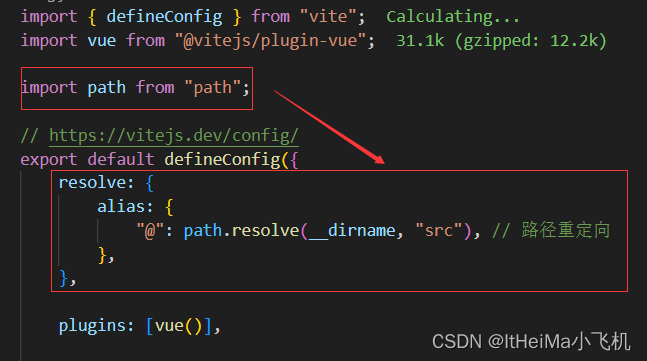
提示:以下是本篇文章正文内容,下面案例可供复制粘贴使用,嘎嘎爽
一、技术栈
Vite 创建 Vue3 项目# 1.创建项目npm create vite@latest# 2.下载依赖npm install# 3.运行项目npm run dev# 1.下载npm install element-plus --save# 2.main.js 引入// main.tsimport { createApp } from 'vue'import ElementPlus from 'element-plus'import 'element-plus/dist/index.css'import App from './App.vue'const app = createApp(App)app.use(ElementPlus)app.mount('#app')# 1.安装npm install vue-router@4npm i nprogress -S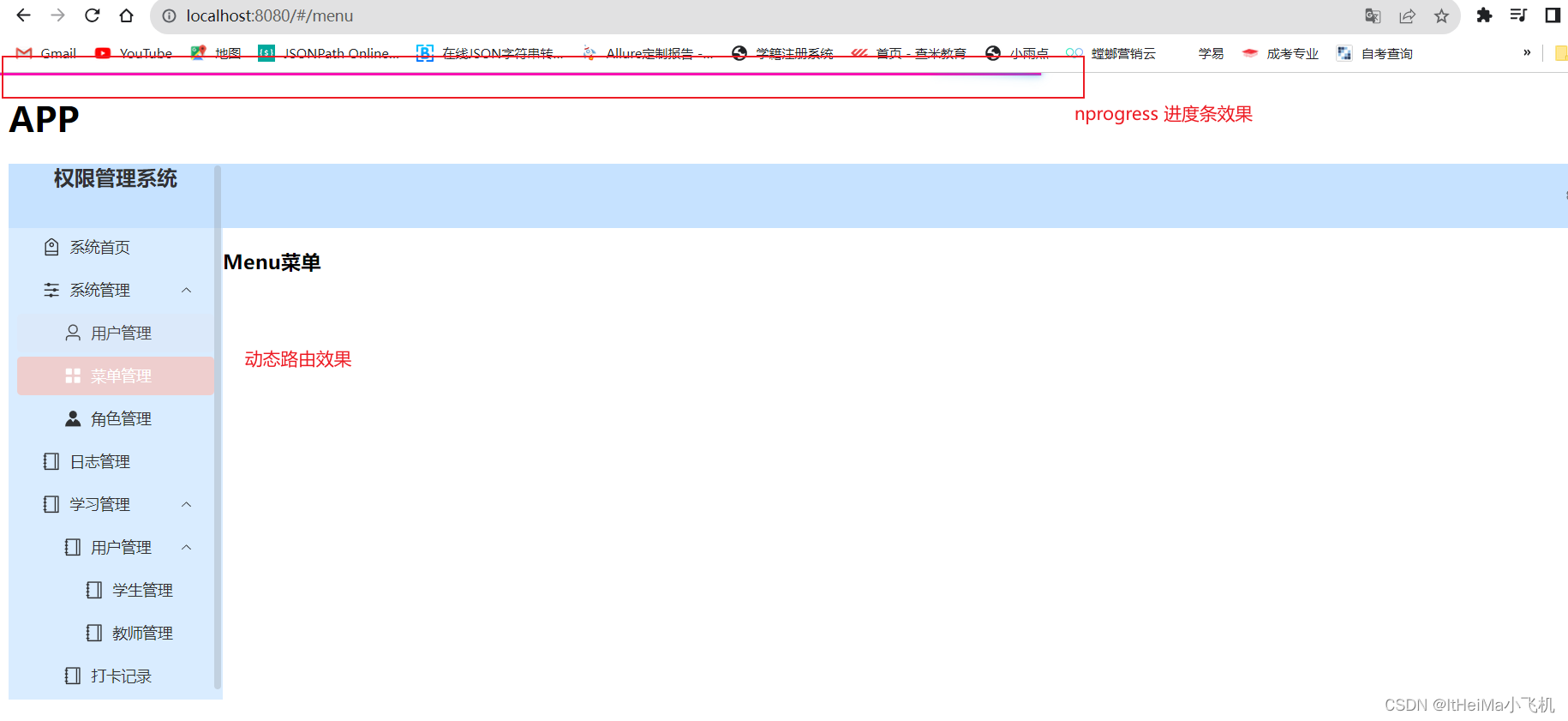
二、项目结构
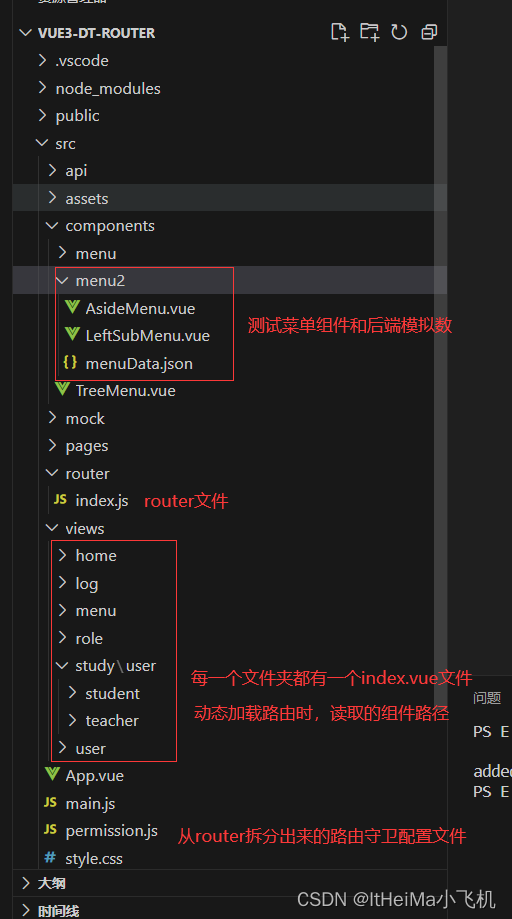
三、菜单组件和数据
说明:
AsideMenu.vue 引用 LeftSubMenu.vue 组件,并父传子传入后端数据LeftSubMenu.vue 组件加载数据menuData.json 后端模拟数据文件1、AsideMenu.vue 组件
代码如下(示例):
<template> <el-menu router :default-active="activeMenu" :class="'menu-left'" :default-openeds="openedsArr" text-color="#fff"> <LeftSubMenu :menuData="treeMenu"></LeftSubMenu> </el-menu></template> <script setup>import LeftSubMenu from "./LeftSubMenu.vue";import { computed } from "vue";import { useRouter } from "vue-router";import treeMenu from './menuData.json';const openedsArr = treeMenu.map((item) => { return item.path;});const activeMenu = computed(() => { const router = useRouter(); const { meta, path } = router.currentRoute.value; if (meta.matchPath2) { return meta.matchPath2; } else { return path; }});</script> <style scoped>.menu-left { flex: 1; padding: 0 8px; border-right: none; background: none;}.menu-left:deep(.el-menu),.menu-left:deep(.el-sub-menu__title:hover) { background: none;}.menu-left:deep(.el-menu-item),.menu-left:deep(.el-sub-menu__title) { height: 36px; margin-bottom: 4px; border-radius: 4px; color: var(--text-main-color) !important;}.menu-left:deep(.el-menu-item:hover .icon),.menu-left:deep(.el-menu-item.is-active .icon) { filter: invert(100%); -webkit-filter: invert(100%);}.menu-left:deep(.el-menu-item:hover),.menu-left:deep(.el-menu-item.is-active) { color: #ffffff !important; background-color: #eecece;}</style>2、LeftSubMenu.vue
代码如下(示例):
<template> <template v-for="item in props.menuData"> <el-sub-menu :key="item.path" v-if="item.children && item.children.length > 0" :index="item.path"> <template #title> <el-icon> <component :is="item.icon"></component> </el-icon> <span>{{ item.meta.title }}</span> </template> <LeftSubMenu :menuData="item.children"></LeftSubMenu> </el-sub-menu> <el-menu-item :key="item.id" v-else :index="item.path" :disabled="item.disabled"> <template #title> <!-- <img class="icon pd-r-10" :src="item.icon" /> --> <el-icon> <component :is="item.icon"></component> </el-icon> <span>{{ item.meta.title }}</span> </template> </el-menu-item> </template></template> <script setup>import LeftSubMenu from "./LeftSubMenu.vue";import { computed, onMounted } from "vue";import { useRouter } from "vue-router";const props = defineProps({ menuData: { type: Array, default: [], },});onMounted(() => { console.log(props.menuData, "Item打印数据");});const curRoute = computed(() => { const router = useRouter(); const { path } = router.currentRoute.value; return path;});</script>3、menuData.json 数据
数据参数说明:
menuType: 0为菜单组,1为菜单(可跳转)children: 子路由数据说明:不复制{ "id": "1", // 唯一id "name": "Home", // 组件名称 "path": "/home", // 路由 "component": "/home/index.vue", // 组件文件位置 "menuType": "1", // 组件类型 "icon": "Discount", // 图标 "sort": 0, // 排序规则 "meta": { "title": "系统首页", // 组件名称 "requiresAuth": null, // 是否需要身份验证 "roles": [], // 用户角色或权限 "breadcrumb": [ // 定义面包屑导航 {} ], "keepAlive": null // 是否需要缓存 }, "children": [] // 子路由 }代码如下(示例):
[ { "id": "1", "name": "Home", "path": "/home", "component": "/home/index.vue", "menuType": "1", "icon": "Discount", "sort": 0, "meta": { "title": "系统首页", "requiresAuth": null, "roles": [], "breadcrumb": [ {} ], "keepAlive": null }, "children": [] }, { "id": "2", "name": "System", "path": "/system", "component": "/system/index.vue", "menuType": "0", "icon": "Operation", "sort": 0, "meta": { "title": "系统管理", "requiresAuth": null, "roles": [], "breadcrumb": [ {} ], "keepAlive": null }, "children": [ { "id": "211", "name": "User", "path": "/user", "component": "/user/index.vue", "menuType": "1", "icon": "user", "sort": 0, "meta": { "title": "用户管理", "requiresAuth": null, "roles": [], "breadcrumb": [ {} ], "keepAlive": null }, "children": [] }, { "id": "222", "name": "Menu", "path": "/menu", "component": "/menu/index.vue", "menuType": "1", "icon": "Menu", "sort": 0, "meta": { "title": "菜单管理", "requiresAuth": null, "roles": [], "breadcrumb": [ {} ], "keepAlive": null }, "children": [] }, { "id": "223", "name": "Role", "path": "/role", "component": "/role/index.vue", "menuType": "1", "icon": "Avatar", "sort": 0, "meta": { "title": "角色管理", "requiresAuth": null, "roles": [], "breadcrumb": [ {} ], "keepAlive": null }, "children": [] } ] }, { "id": "3", "name": "Log", "path": "/log", "component": "/log/index.vue", "menuType": "1", "icon": "Notebook", "sort": 0, "meta": { "title": "日志管理", "requiresAuth": null, "roles": [], "breadcrumb": [ {} ], "keepAlive": null }, "children": [] }, { "id": "4", "name": "Study", "path": "/study", "component": "/study/index.vue", "menuType": "0", "icon": "Notebook", "sort": 0, "meta": { "title": "学习管理", "requiresAuth": null, "roles": [], "breadcrumb": [ {} ], "keepAlive": null }, "children": [ { "id": "441", "name": "StudyUser", "path": "/studyUser", "component": "/study/user/index.vue", "menuType": "0", "icon": "Notebook", "sort": 0, "meta": { "title": "用户管理", "requiresAuth": null, "roles": [], "breadcrumb": [ {} ], "keepAlive": null }, "children": [ { "id": "4441", "name": "Student", "path": "/student", "component": "/study/user/student/index.vue", "menuType": "1", "icon": "Notebook", "sort": 0, "meta": { "title": "学生管理", "requiresAuth": null, "roles": [], "breadcrumb": [ {} ], "keepAlive": null }, "children": [] }, { "id": "4442", "name": "Teacher", "path": "/teacher", "component": "/study/user/teacher/index.vue", "menuType": "1", "icon": "Notebook", "sort": 0, "meta": { "title": "教师管理", "requiresAuth": null, "roles": [], "breadcrumb": [ {} ], "keepAlive": null }, "children": [] } ] }, { "id": "3", "name": "Log", "path": "/log", "component": "/log/index.vue", "menuType": "1", "icon": "Notebook", "sort": 0, "meta": { "title": "打卡记录", "requiresAuth": null, "roles": [], "breadcrumb": [ {} ], "keepAlive": null }, "children": [] } ] }]四、router 配置
说明:
router.addRouter({}) 函数即动态路由,它是临时性的,就是一旦刷新就会清除掉添加的动态路由信息需要重新定位到 localhost:8080 来刷新,重新获取路由信息,方便调试因为是前端静态数据,所以正常,只要连接后端,请求数据后,缓存本地,每次刷新从本地获取即可文章只是完成动态路由的实现,数据的持久性存储,各位根据自己项目自身完善1、router/index.js
代码如下(示例):
import { createRouter, createWebHashHistory} from 'vue-router';import NotFound from '@/pages/404/404.vue' // pages 文件下创建404文件,再创建一个404.vueconst routes = [ { path: "/", component: () => import('@/pages/manage/ManageMain.vue') }, // 登录页 { path: "/manage", name: 'Manage', component: () => import('@/pages/manage/ManageMain.vue'), // 主页 }, { path: '/:pathMatch(.*)*', name: 'NotFound', component: NotFound },]const router = createRouter({ // 4. 内部提供了 history 模式的实现。为了简单起见,我们在这里使用 hash 模式。 history: createWebHashHistory(), routes, // `routes: routes` 的缩写})// 导出实例, permission.js 引入export default router2、permission.js (与main.js 同级)
说明:
注意 NProgress 的引入、配置、使用动态路由的添加(主要是 router.addRoute ,其他的都是根据后端 json 文件的参数来判断,不同的参数配置,不同的判断,这只是我喜欢的参数配置)路径的拼接(component: () => import(/* @vite-ignore */./views${item.component}))具体的根据自己的情况配置,打印就知道了,按照我的配置,就不需要改动 代码如下(示例):
// 说明:路由守卫文件// 引入import router from "./router";// 判断用户无token 返回登录页提示有用import { ElMessage } from 'element-plus';// 进度条import NProgress from 'nprogress';// 简单配置 进度条,可以不配置:在axios中我们不再做配置,以用来区分。NProgress.inc(0.2)NProgress.configure({ easing: 'ease', speed: 500, showSpinner: false })// 一、前置守卫router.beforeEach((to, from, next) => { // 进度条 NProgress.start(); // 1、动态路由 addRoutes(); // 2、中间处理(token) // 3、最后放行 next();})// 动态路由获取:注:之后完善项目直接考虑在登录的时候直接获取// 直接缓存在 pinia 里// 这里直接取数据,不请求import { getTreeMenu } from '@/api/index.js';import menuData from '@/components/menu2/menuData.json';function addRoutes() { // 1、后端数据 createRouters(menuData); console.log("router/index.js打印router已有的路由信息", router.getRoutes());}// 拼接路由function createRouters(result) { result.forEach((item) => { // 1、类型为0的菜单,子路由不为空,将子路由添加到manage里 if (item.menuType === '0' && item.children.length > 0) { item.children.forEach((children) => { createRouterTemplate('Manage', children); }) } // 2、menuType == 1, 子路由为空 if (item.menuType === '1' && item.children.length === 0) { createRouterTemplate('Manage', item); } // 3、递归层级 if (item.children.length > 0) { createRouters(item.children); } });}// 把router 的动态路由进行封装function createRouterTemplate(fatherRouter, item) { router.addRoute(fatherRouter, { path: item.path, name: item.name, meta: { title: item.meta.title, // 面包屑用 requiresAuth: item.meta.requiresAuth, roles: item.meta.roles, breadcrumb: item.meta.breadcrumb, keepAlive: item.meta.keepAlive }, // /* @vite-ignore */ :处理vite动态导入的警告 component: () => import(/* @vite-ignore */ `./views${item.component}`) })}// 二、后置守卫router.afterEach((to) => { // 标签抬头 document.title = to.meta.title; // 进度条 NProgress.done();})// main.js 导入的为这个routerexport default router3、main.js
说明:
1.注意 router 的引用文件2.注意 nprogress 的引用3.注意全局定义Element-Plus图标4.注意Vue3动态图标的使用# Vue3 动态图标的使用 <el-icon><component :is="item.icon"></component></el-icon>代码如下(示例):
import { createApp } from 'vue'import './style.css';import ElementPlus from 'element-plus';import 'element-plus/dist/index.css';import App from './App.vue';// import router from './router'; // 原routerimport router from './permission'; // 现router//Icon全局引入import * as icons from "@element-plus/icons-vue";// 进度条import 'nprogress/nprogress.css';const app = createApp(App);// ElementPlusapp.use(ElementPlus);// Icon全局注册Object.keys(icons).forEach(key => { app.component(key, icons[key])})app.use(router);app.mount('#app')五、效果
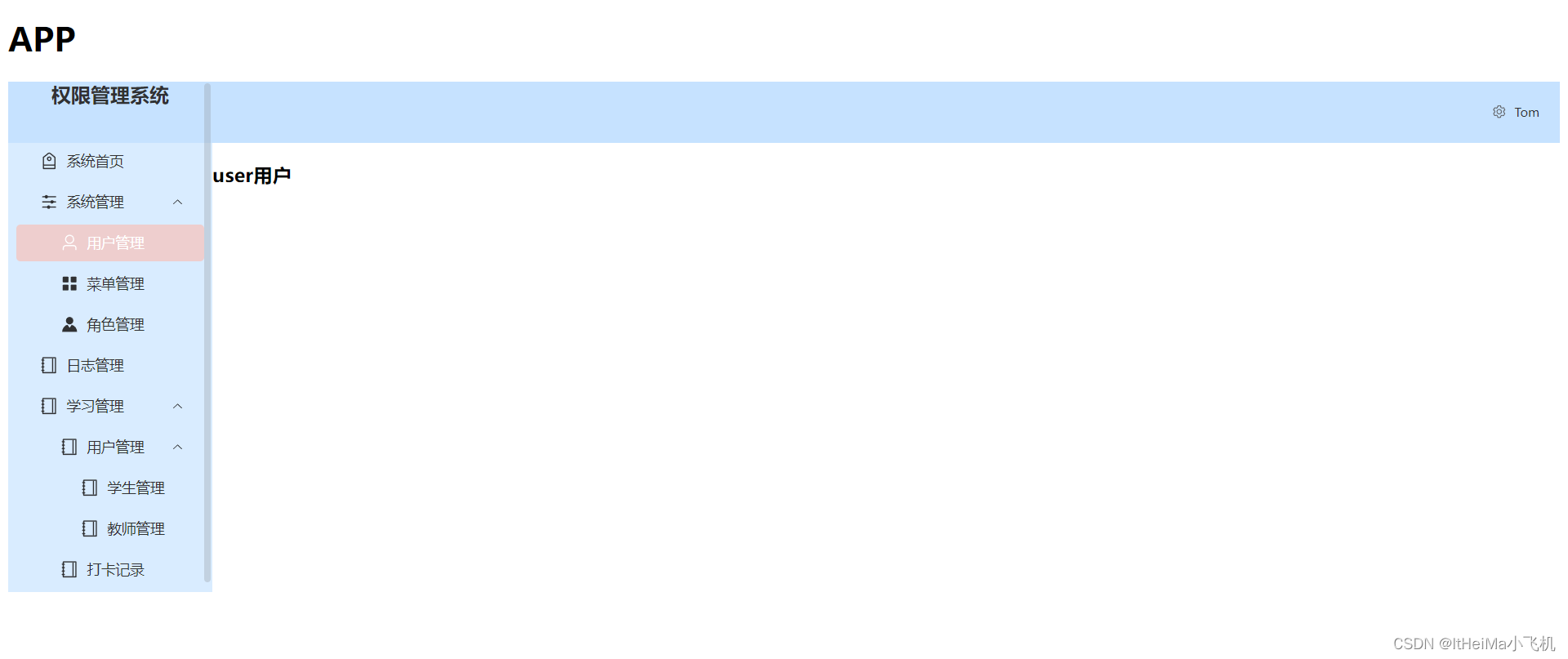
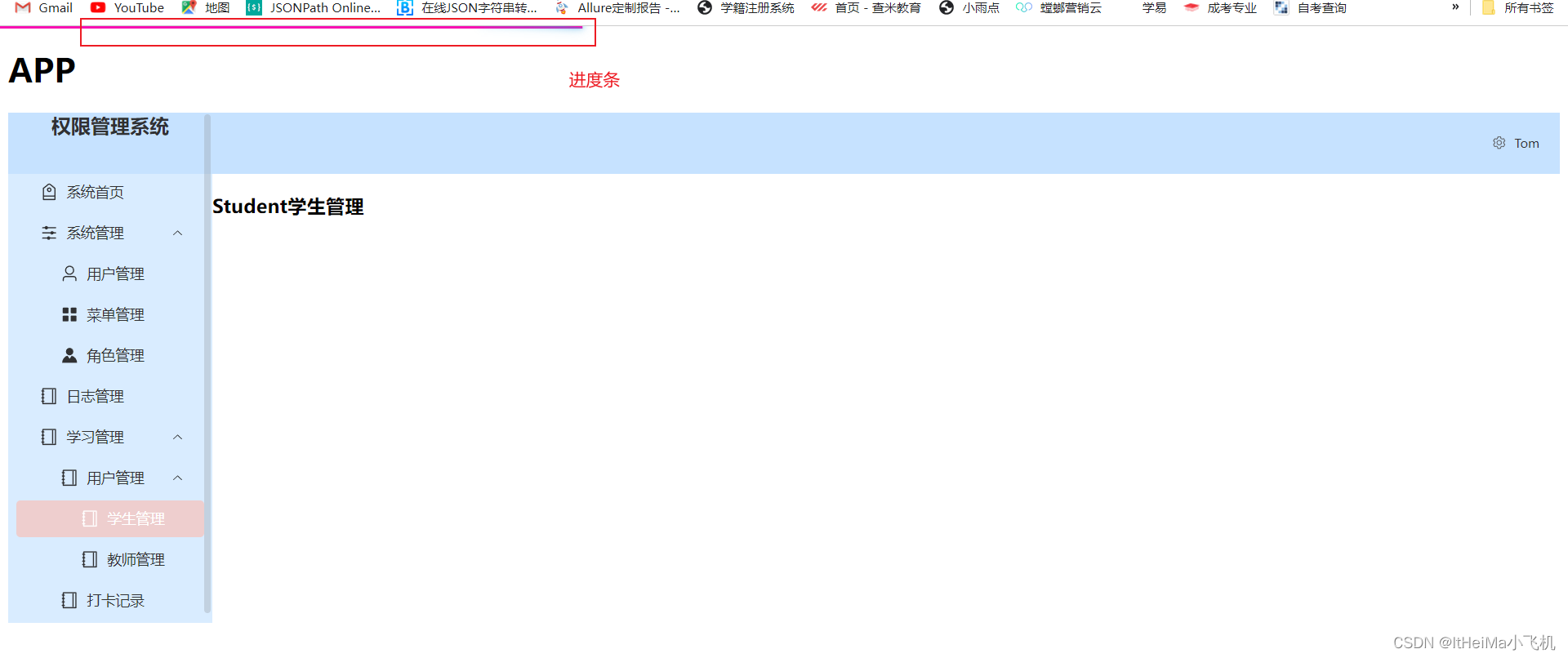
删除menuData.json 文件的某一个路由,界面将不展示!!!
六、给个点赞和收藏
七、参考文献
参考文章 — https://www.cnblogs.com/lpkshuai/p/17346600.html